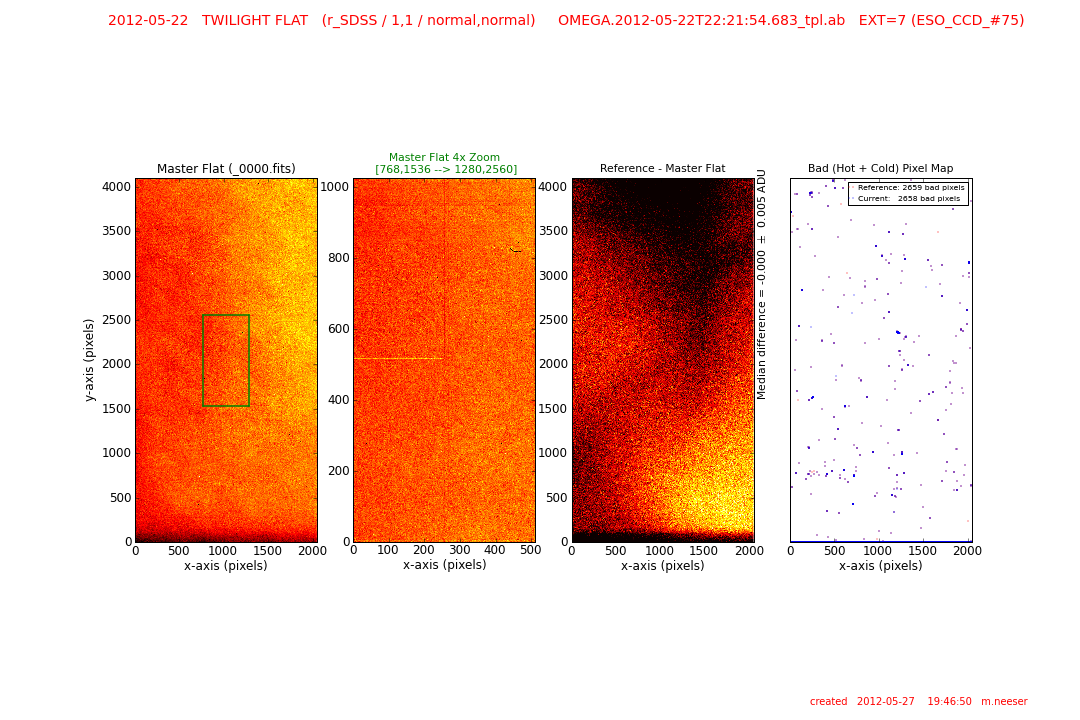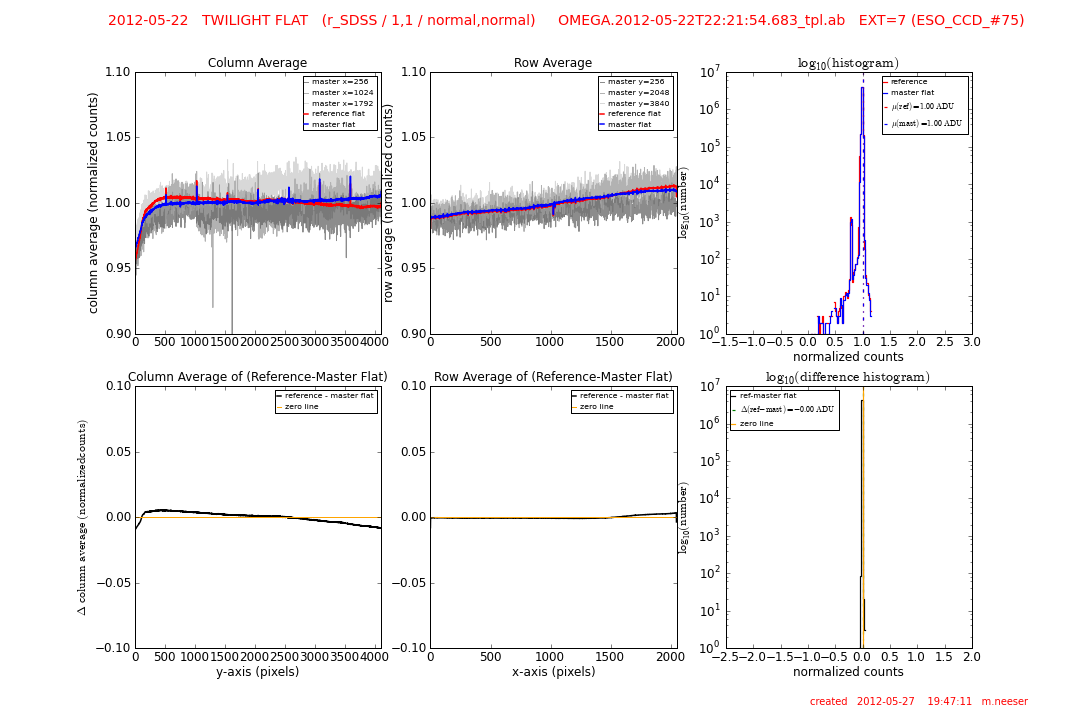|
|
 |
During normal VST/OmegaCAM operations TWILIGHT flat frames are taken for each filter for which science data was obtained, and generally have a validity range of 7 days. They usually consist of 4 input, screen flat exposures (each with a flux level of about 20,000 ADU or more). Although the twilight template generally consists of 5 sky flats, the first frame is made to determine a good count-to-exposure time ratio and therefore it is excluded from the master twilght recipe. The input frames are bias-corrected, trimmed, corrected for bad pixels (hot and cold pixels), and averaged together with a 5 sigma rejection of outliers (intended to reduce photon shot noise and to remove cosmic rays).
The pipeline creates three output frames from its flat recipe (omega_mflat): a master twilight flat (OC_MFLT_<date>_1_1_normal_normal_<filter>.fits), a master flat (OC_MFLA_<date>_1_1_normal_normal_<filter>.fits) which is a combination of the master dome flat (for the pixel-to-pixel variations) and the master twilight flat (to account for the global shape of the flat field), and a bad pixel map combined from the hot and cold pixel maps (OC_MBPM_<date>_1_1_normal_normal_<filter>.fits).
 |
An OmegaCAM master flat combined from twilight and dome master flats (single detector). |
 |
An OmegaCAM master bad pixel map combined from the hot and cold pixel maps (single detector). A value of 1 indicates a cold pixels; otherwise 0.
|
top
TWILIGHT parameters trended
|
QC1 Health Check Plots
The QC1 health check plots for the RAW OmegaCAM twilight flats are divided into 7 separate linked pages, each of which shows the trending for each of 7 different filters. Since the master twilight flat produced by the OmegaCAM pipeline is normalized, it is not easy to detect whether or not one of the input twilight flat frames was either saturated or had insufficient flux. For this reason, the raw twilight flat parameters are monitored. A further set of QC1 health check plots exist for the OmegaCAM master flats monitoring both the level and the number of detected bad (hot + cold) pixels.
- for each of the filters: u_SDSS, g_SDSS, r_SDSS, i_SDSS, z_SDSS, B_JOHN, and V_JOHN:
- raw twilight flats median level averaged over all 32 detectors
- raw twilight flat median level for each detector
- raw twilight minimum and maximum level averaged over all 32 detectors
- score outliers
- for ALL filters (possible since the master flats are normalized):
- master twilight flat median level averaged over all 32 detectors
- master twilight flat median level for each detector
- master twilight flat rms averaged over all 32 detectors
- score outliers
- number of bad (hot + cold) pixels averaged over all 32 detectors
- number of bad pixels for each detector
- score outliers
QC1 parameters (trended for each individual detector)
| Parameter |
Table: Name (QC1 database) |
Description of Procedure |
| median level of master flat |
omegacam_twilight: qc.flat.median |
The median level of the master flat (normalized) frame for each extension (ADU). |
mean level of master flat
|
omegacam_twilight: qc.flat.mean |
The mean level of the master flat (normalized) frame for each extension (ADU). |
| standard deviation of master flat |
omegacam_twilight: qc.flat.std |
The standard deviation of the master flat (normalized) frame for each extension (ADU). |
| number of bad pixels |
omegacam_twilight: qc.bad.pixels |
The number of bad (hot + cold) pixels as combined from input master_BIAS (hot pixels map) and master_DOMEFLAT (cold pixels map) for each extension. The recipe does not calculate or add new bad pixels. |
| raw twilight minimum flux |
omegacam_twilight: qc.raw.twilight.min |
the median flux level of the input raw twilight flat having the minimum average flux level (ADU). This QC parameter is used to ensure that the weakest sky flat has enough flux to create a statistically accurate master twilight flat. |
| raw twilight maximum flux |
omegacam_twilight: qc.raw.twilight.max |
the median flux level of the input raw twilight flat having the largest average flux level (ADU). This QC parameter is used to ensure that the sky flat with the most flux does not reach the saturation limits of the detector. |
| raw twilight median/mean/standard deviation |
omegacam_twilight: qc.raw.twilight.median/mean/std |
the statistics (median, mean, and standard deviation) of all input raw twilight flats (ADU). |
| average temperature of the two detector plate probes |
omegacam_twilight: qc.temp.mosaic.plate |
The average value of the header temperature keyword DET.TLM5 and DET.TLM8, both of which probe the temperature of the mosaic plate (Kelvin). |
QC Reports for TWILIGHT flat frames

QC Report 1:
left: full-field image of the master flat (twilight + dome flat) of the extension listed at the top of the image
center left: 4x zoom of the center area of the master flat
center right: the difference of the reference master flat and the current master flat frames The median level of the difference image is listed to the right of the frame
right: full-field image of the bad pixel map (hot + cold pixels). The positions of the reference frame bad pixels are shown in red, while the bad pixels of the current dome flat frame are shown in blue.
The total numbers of bad pixels are listed in the frame legend.

QC Report 2:
top left: a) three single column traces of the current and reference master flats through:
x = 256 (dark grey)
x = 1024 (middle grey)
x = 1792 (light grey)
b) average of all columns (normalized) of current master flat (thick blue line)
c) average of all columns (normalized) of reference master flat (thick red line)
top center: a) three single row traces of the current and reference master flats through:
y = 256 (dark grey)
y = 2048 (middle grey)
y = 3840 (light grey)
b) average of all rows (normalized) of current master flat (thick blue line)
c) average of all rows (normalized) of reference master flat (thick red line)
top right: a) logarithmic histogram of current master flat (blue line)
b) logarithmic histogram of reference master flat (red line)
The median levels (as computed from a Gaussian fit) are shown as vertical dashed lines and listed in the legend
lower left: difference between the average column traces of the reference and current master flat frames
lower center: difference between the average row traces of the reference and current master flat frames In both plots, the zero line is shown in orange as a reference.
lower right: logarithmic histogram of the difference between the reference and current master flat frames. Ideally, the histogram should straddle the zero line (shown in orange).
The median difference (as computed from a Gaussian fit) is shown as vertical dashed green line.

QC Report 3:
left: full-field image of the second raw twilight flat executed in the template
center: full-field image of the last raw twilight flat executed in the template
top right: a) six single column traces of the current raw twilight flats through:
x = 256 (dark grey) for the second and last raw twilight flats
x = 1024 (middle grey) for the second and last raw twilight flats
x = 1792 (light grey) for the second and last raw twilight flats
b) average of all columns of the second raw twilight flat (thick red line)
c) average of all columns of the last raw twilight flat (thick blue line)
bottom right: a) six single row traces of the current raw twilight flats through:
x = 256 (dark grey) for the second and last raw twilight flats
x = 1024 (middle grey) for the second and last raw twilight flats
x = 1792 (light grey) for the second and last raw twilight flats
b) average of all rows of the second raw twilight flat (thick red line)
c) average of all rows of the last raw twilight flat (thick blue line)
Trending and Issues
Since the master twilight flat produced by the OmegaCAM pipeline is normalized, it is not easy to detect whether or not one of the input sky flat frames was either saturated or had insufficient flux. For this reason, the raw twilight flat statistics are monitored. QC report #3 will clearly show a saturated raw twilight, or a raw twilight with too little flux. Both parameters are monitored and scored.
All saturated sky flats are rejected and reported to Paranal.
History
OmegaCAM TWILIGHT flats tend to be very stable.
|
![[ ESO ]](/images/eso-logo.gif)
![[ ESO ]](/images/eso-logo.gif)
